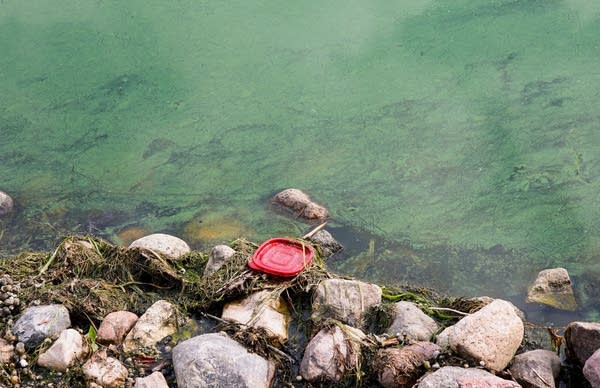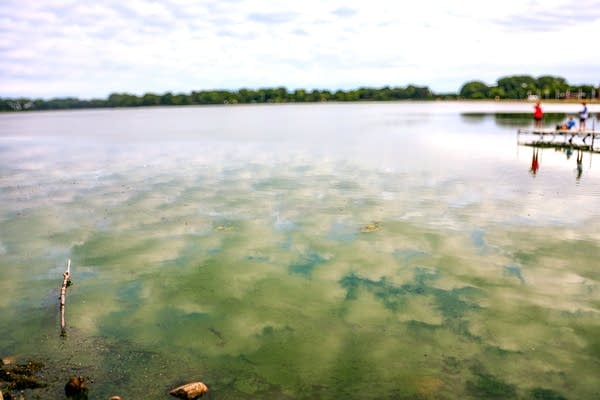On a quiet, summer day, Laurie Hammerschmidt and her dog Daisy, a five-year-old boxer, take their routine walk around the shore of Sleepy Eye Lake.
“Daisy likes to walk along the beach, it’s her favorite place to go,” Hammerschmidt, 60, said. “And then she goes and does the ‘zoomies,’ as they call them. She doesn’t go in the water unless I walk in the water with her.”
Since Daisy doesn’t swim, Hammerschmidt isn’t worried about her jumping into the lake. But, she is concerned about the water quality, because it recently looked — scuzzy.
“It just looked like a green-blue slime floating on the water, almost like an oil slick,” Hammerschmidt said. “It was around the whole [beach] It was solid all the way around.”

The slime Hammerschmidt describes is a toxic blue-green algal bloom, which forced the city of Sleepy Eye to close the beach for about ten days. Other lakes and beaches across Minnesota have been closed this summer too, as hotter and wetter weather appears to be making these potentially dangerous algal blooms more frequent.
In Minneapolis, for example, the Park and Recreation Board issued a hazardous algae advisory for two beaches on Lake Nokomis on Wednesday, the main beach and the 50th Street beach, as bacteria in water samples exceeded the state standard.
Algal blooms aren’t a type of algae at all, but a form of bacteria, according to the Minnesota Department of Health. Not all algal blooms are toxic, but it’s impossible to know just by looking at them; the water and substance must be tested. If it is the toxic variety, people and animals can be exposed by swallowing or by making skin contact with the bacteria.

“Toxic algal blooms, or blue-green algae, as they’re sometimes referred to, kind of look like spilled green paint or pea soup on water,” said Trisha Robinson, waterborne disease supervisor at MDH “So in people … this might be symptoms that could include things like vomiting, diarrhea, skin irritation, eye irritation, cough, sore throat, headache.”
So far this summer, Robinson said there have been very few reports of people getting sick from toxic algal bloom exposure, but there have been several reports of dogs getting sick.
“They (dogs) are a lot less discerning in terms of the types of water that they go into,” she said. “And so, they may drink up the water around a harmful algal bloom. And so, they can get really sick, really quickly, and have those more severe symptoms that often can lead to death pretty quickly too, unfortunately.”
A growth of algal blooms
According to the Minnesota Pollution Control Agency, blue-green algal blooms — or cyanobacteria — need certain conditions in order to grow and thrive. Kim Laing, the MPCA’s surface water monitoring manager, says algal blooms need sunlight, warm and still or slow-moving water, and nutrients such as nitrogen and phosphorus.
“Those are kind of like a garden,” Laing said. “You need all of those things for growth. And the same thing happens in the water. We need those nutrients (and) warm temperatures to grow that cyanobacteria. A few degrees might seem insignificant, but the ramifications to natural conditions can be monumental.”
Laing said heavy rainfall — and many areas in Minnesota have been getting a lot of it this summer — increases nutrient runoff, especially in areas with a lot of farmland, golf courses, and urban and suburban development.

“If those rains aren’t filtering through rain gardens and buffers (such as wetlands) along streams, then those nutrients can be delivered quickly to our water bodies,” she said, adding that everyone can do their part to reduce the impact of algal blooms.
“What we can all do is help minimize the nutrients getting to water bodies by doing rain gardens, putting in rain barrels, doing land practices that help minimize erosion and nutrient loss to our water bodies.”
‘Hopefully, it doesn’t come back’
After their walk, Laurie Hammerschmidt and her dog, Daisy, are ready to head home. She was sad to see the blue-green algae bloom contaminate the lake but even sadder to see how quiet the park and shoreline had become as swimmers, boaters and anglers stayed away.
Now, after winds picked up and the algal blooms dissipated, Sleepy Eye Lake Beach has reopened and Hammerschmidt is happy to see anglers tossing their fishing lines from the docks and people back out on the water in kayaks and motor boats. says she hopes to see people back out on the water now that the blooms have dissipated.
“The bass have been great out of this lake,” Hammerschmidt said. “People have really been doing a lot of bass fishing out of here … (I’m) glad the water cleared up, so hopefully that won’t be an issue for them either. Hopefully, (the bloom) doesn’t come back.”
Hammerschmidt is one of many Minnesotans hoping for clearer waters, free of algal blooms, the rest of the summer.





